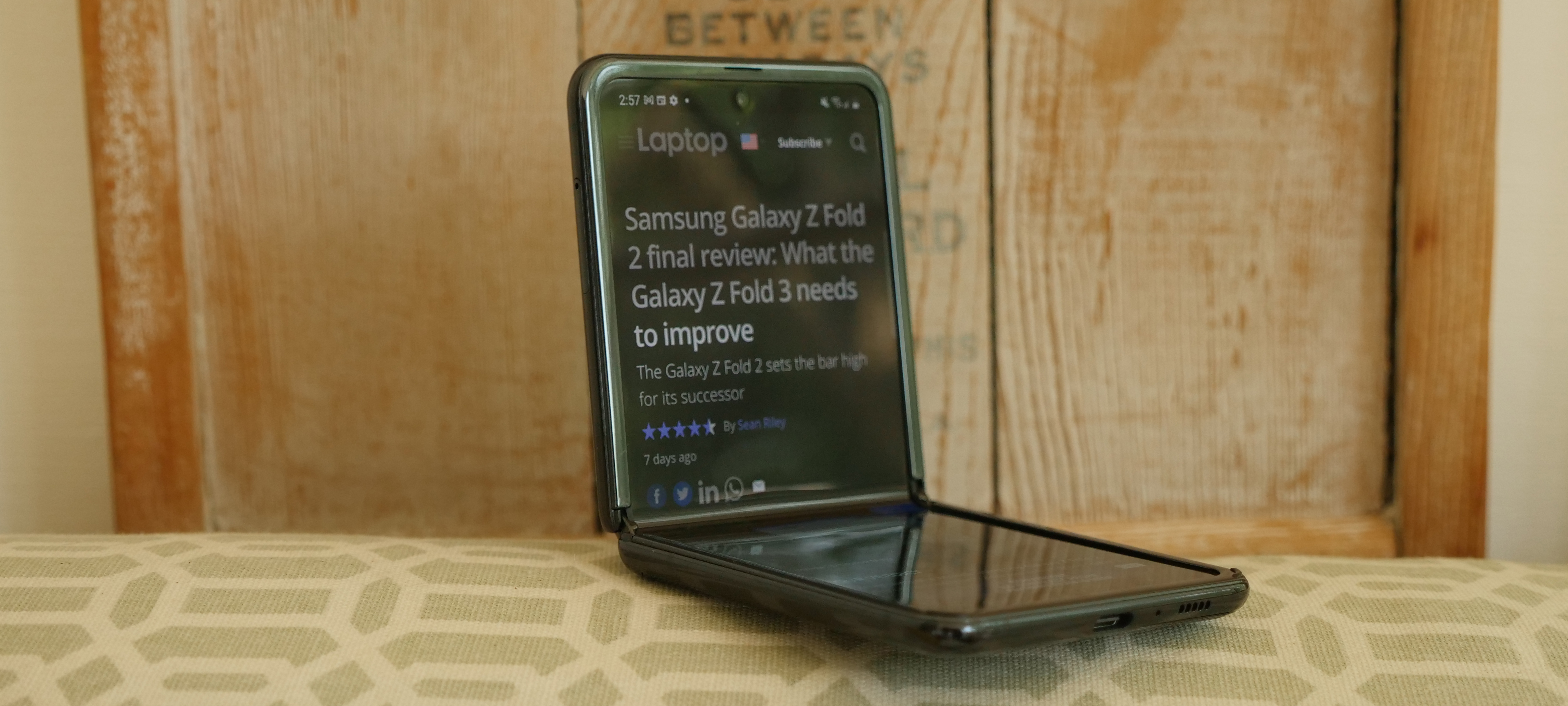Laptop Mag Verdict
The Galaxy Z Flip 5G went a long way to fixing the issues with the original, can the Galaxy Z Flip 3 take it mainstream?
Pros
- +
Unique form factor
- +
Vivid and bright display
- +
Excellent photo/video quality
- +
Affordable for the category
- +
Unmatched software support
Cons
- -
Lacks a 120Hz display
- -
No telephoto zoom lens
- -
Disappointing battery life
Why you can trust Laptop Mag
Price: $1,199
OS: Android 11 / One UI 3.1
Displays: 6.7-inch (2636 x 1080) AMOLED; 1.1-inch (300 x 112) AMOLED (cover)
CPU: Qualcomm Snapdragon 865 Plus
RAM: 8GB
Rear cameras: 12MP wide (ƒ/1.8); 12MP ultrawide (ƒ/2.2)
Front cameras: 10MP (f/2.0)
Storage: 256GB
Battery: 8:16
Size: 6.6 x 2.9 x 0.28 inches (open); 3.4 x 2.9 x 0.61 inches (closed)
Weight: 6.5 ounces
The Galaxy Z Flip 5G is technically the second generation Z Flip; it takes the already impressive design of its predecessor and adds5G and an upgraded Qualcomm Snapdragon 865 Plus processor.
The Galaxy Z Flip benefited from the original Galaxy Fold by learning the pitfalls of foldables and launching fully baked rather than having to be tossed back into the oven to finish cooking. The Galaxy Z Flip 5G is about nine months old, but at launch, it matched the specs of other flagships and without the premium pricing of the Galaxy Z Fold 2.
While it doesn’t quite have the new paradigm feel of the Galaxy Z Fold 2, the Galaxy Z Flip 5G captures the attention of users with a smaller design that flips to showcase a large screen. After a few weeks with the Galaxy Z Fip 5G, I understand the appeal. In this review, I'll look at how it holds up to the competition and consider how the Galaxy Z Flip 3 could push the Z Flip series into the mainstream.
Samsung Galaxy Z Flip 5G: Price
The Galaxy Z Flip 5G is the more affordable of Samsung’s current foldables; originally starting at $1,449, it got a permanent price cut to $1,199 earlier this year. This is on par with top flagship phones like the iPhone 12 Pro Max or Samsung’s Galaxy S21 Ultra, but a far cry from the $1,799 Galaxy Z Fold 2.
Like the Fold, the Galaxy Z Flip 5G has a single configuration, which features a Snapdragon 865 Plus processor, 8GB of RAM, and 256GB of storage. Those are flagship specs or, at least, they were when the Galaxy Z Flip 5G launched last fall.
While $1,199 isn’t anywhere near the $1,799 price of the Galaxy Z Fold 2, this premium price relative to the specs is one of the main reasons our panel of experts said foldables aren’t catching on. The Galaxy Z Flip 5G occasionally dips to $999, but you may want to wait because the Galaxy Z Flip 3 price could be more affordable on day one.
Rumors suggest a roughly 20% price drop for Samsung’s new lineup of foldables for this year, mirroring what we saw with the Galaxy S21 pricing earlier this year. That would place it somewhere in the range of $1,149 to $1,199, aligning with the now-discounted price of the Galaxy Z Flip 5G.
Sign up to receive The Snapshot, a free special dispatch from Laptop Mag, in your inbox.

Samsung Galaxy Z Flip 5G: Design
Unlike its larger folding sibling, the Galaxy Z Flip 5G doesn’t have the baggage of a previous model with durability and design concerns. Samsung already learned those lessons and used the new and improved hinge design on the Z Flip. Also unlike the Galaxy Z Fold 2, the Flip 5G can fold flat so nothing can sneak in between the two halves of the interior display when closed.
It is an oddity when resting on a table; most of us haven’t carried a clamshell phone in years and the thick, roughly square dimensions of the phone when folded (3.4 x 2.9 x 0.68 inches), aren't what we're accustomed to anymore. In its unfolded state, the Z Flip 5G is one of the thinnest phones on the market at 6.6 x 2.9 x 0.28 inches. While it’s slightly less of an attention grabber than the Fold, watching someone fold their phone in half is going to raise some interest.
While the folded Galaxy Z Flip 5G isn’t kind to those that wear skinny pants, it is a welcome reprieve from the massive flagships I typically carry around. From a durability standpoint, it’s great because, unlike the Fold models, you don’t have a large display exposed on the exterior; everything is safely housed in folded mode. With that said, the Z Flip 5G lacks water or dust resistance, something which is rumored to be coming with the Galaxy Z Flip 3.
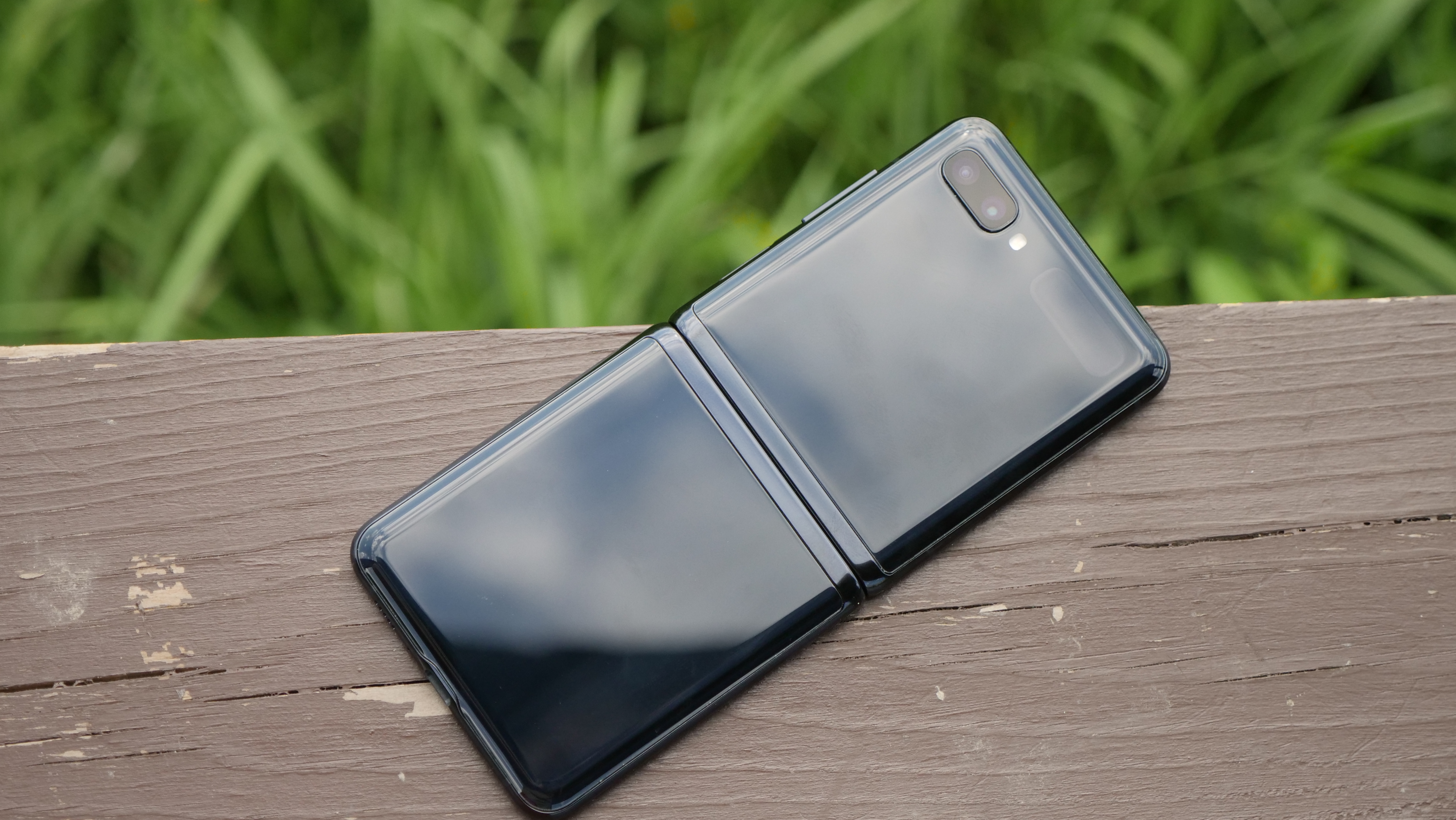
If you’ve missed closing your phone to end a call, I’m here to confirm that it is still incredibly satisfying, particularly if it’s a telemarketer that got through your spam filtering. On that subject, the hinge feels robust enough that I don’t worry about the act of opening and closing it somehow damaging the phone. It holds the display in place wherever you stop opening it, which allows for some fun options with photography or when making a video call.
The biggest design criticism I have for the Galaxy Z Flip 5G is the size of its exterior cover display which I’ll touch on more in the next section. Otherwise, this feels like a polished design.
Samsung Galaxy Z Flip 5G: Displays
The Galaxy Z Flip 5G features a 6.7-inch, (2636 x 1080) AMOLED Samsung display on its interior, while the tiny exterior cover display is just 1.1 inches (300 x 112). These are both standard 60Hz displays, which is disappointing considering Samsung’s affordable Galaxy S20 FE delivered a 120Hz refresh rate last year.
For those who used traditional clamshell flip phones, the little cover display on the Galaxy Z Flip 5G feels reminiscent of the exterior display seen on those phones in the early 2000s. You get the time, a tiny snippet of a notification, and you can even use it as a viewfinder for selfies. Text is crisp and clear, but ultimately, its size precludes much utility. Fortunately, this is set to change with the Galaxy Z Flip 3 as leaked images have shown its cover display has roughly doubled in size.
The interior display, on the other hand, is among the largest on the market at 6.7 inches, which matches the likes of the iPhone 12 Pro Max and is just shy of the Galaxy S21 Ultra. Like the Galaxy Z Fold 2 and all current foldables, it has a crease across the middle The crease is occasionally invisible but a slight distortion is often noticeable depending on the angle and what’s being displayed.
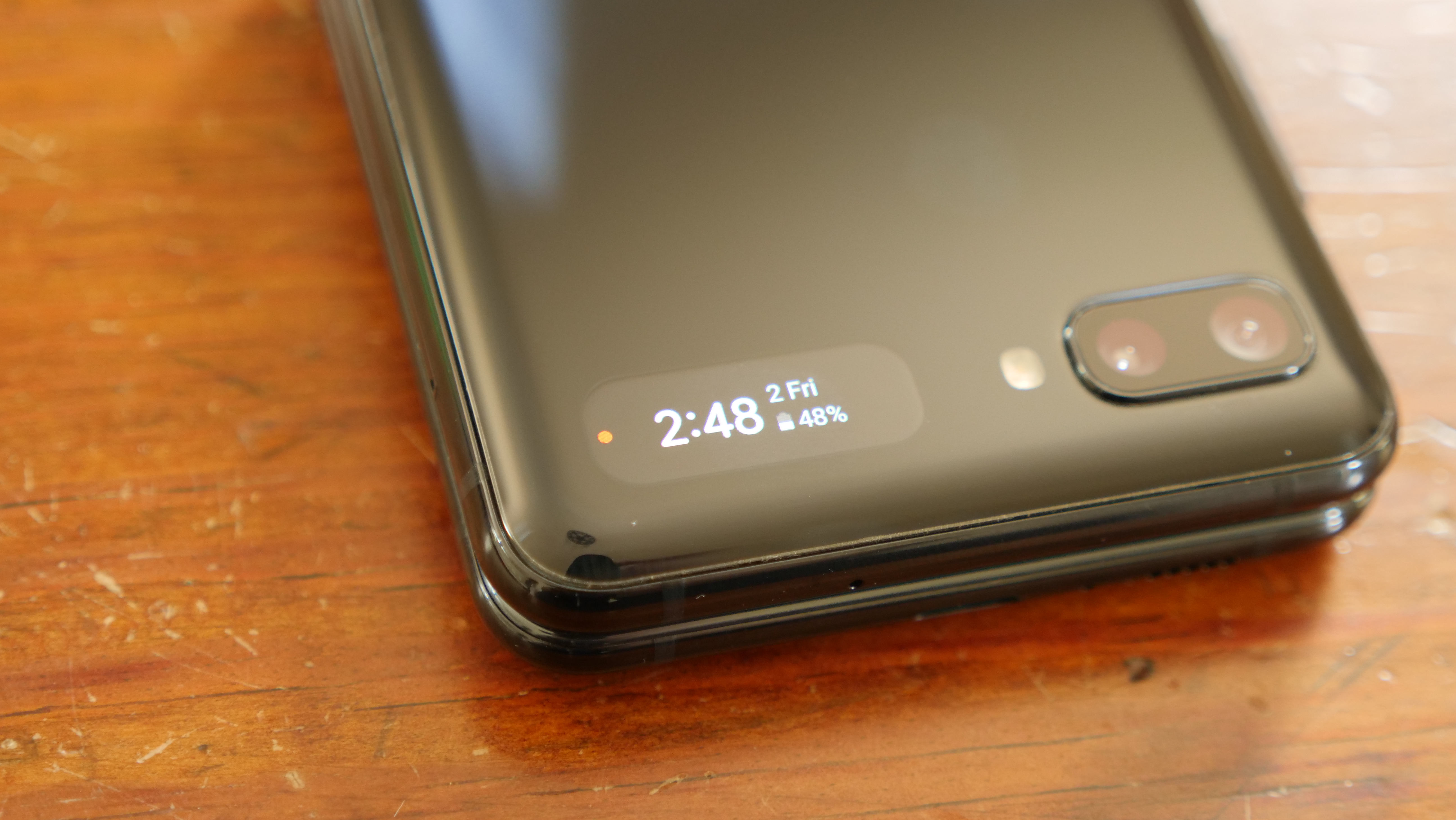
Even the $240 OnePlus Nord N200 5G uses a 90Hz display, so the drop to 60Hz on the Galaxy Z Flip 5G is jarring if you have become accustomed to the higher refresh rates. There is little question that the Galaxy Z Flip 3 will bump up to 120Hz, heck, Samsung even brought 120Hz to its A-Series this year.
With that said, nothing else about the display disappoints; it’s a stellar AMOLED from Samsung, covering 142.2% of the DCI-P3 color gamut on its vivid setting or 86.6% on its natural setting. That comes in ahead of the Galaxy S21 Ultra (81.4%) and the iPhone 12 Pro Max (84.8%).
And it isn’t just a saturated mess; in the natural setting, it performed excellently on the Delta-E color accuracy test (lower is better) with a 0.21, well ahead of the Galaxy S21 Ultra (0.35). The Galaxy Z Flip 5G holds up well in any lighting with a max of 677 nits of brightness. While the Galaxy S21 Ultra (821 nits) beats it, that’s the brightest phone we’ve ever tested; the iPhone 12 Pro Max (655 nits) couldn’t keep pace.
I watched the new “Shang-Chi and the Legend of the Ten Rings” trailer to see how the Galaxy Z Flip 5G performed and it did not disappoint. With the display in its vivid setting, the vibrant colors of the gorgeous environments and costuming came through crisply and cleanly, while the depth of lighting and color were equally entrancing. When it comes to consuming video content on the Galaxy Z Fip 5G, it’s the equal of any Samsung phone on the market, which is to say, the best mobile displays available.
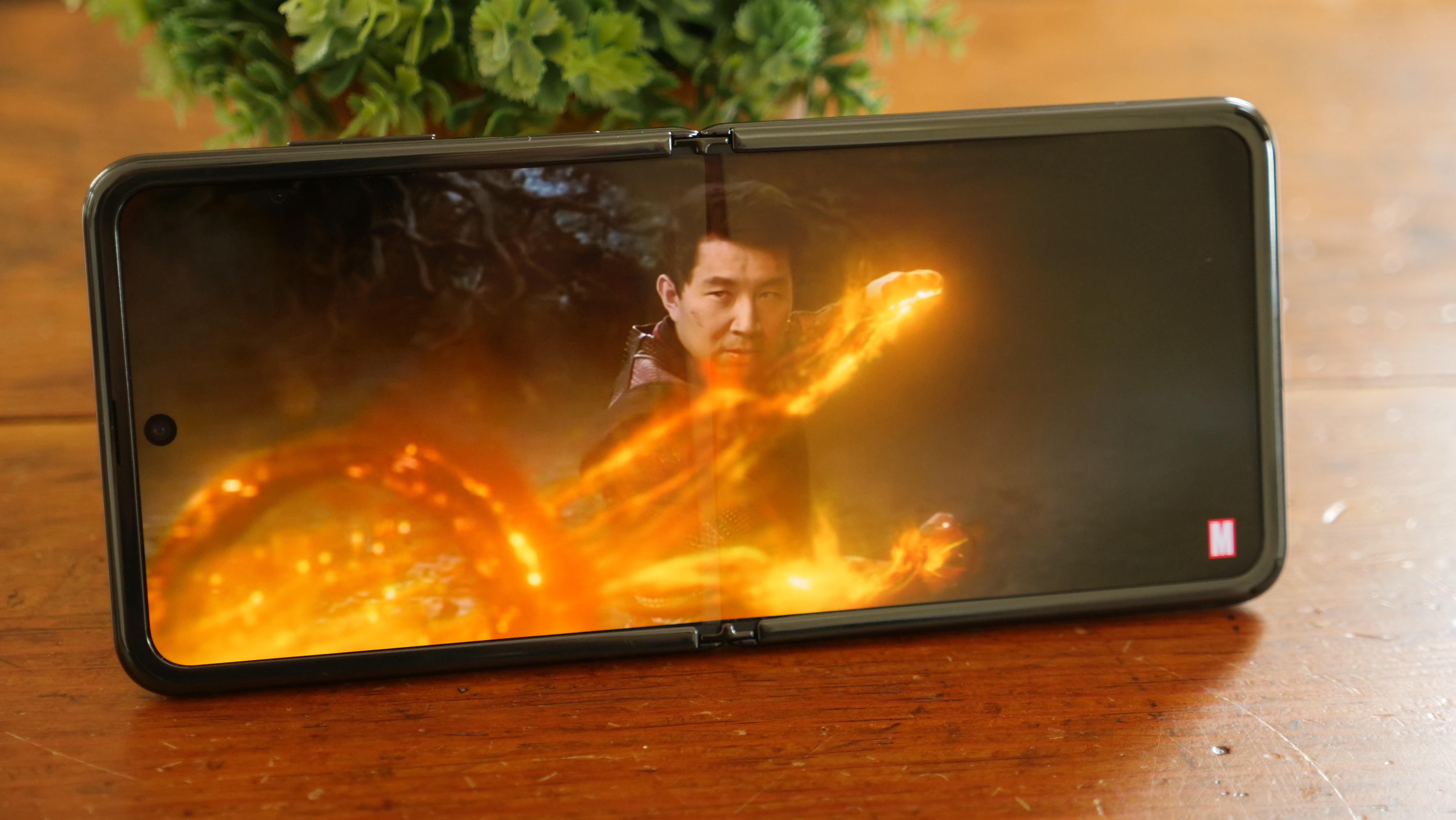
Samsung Galaxy Z Flip 5G: Performance
The Galaxy Z Flip 5G features the Snapdragon 865 Plus processor, mirroring the Galaxy Z Fold 2 and the Galaxy Note 20 Ultra. This is paired with 8GB of RAM and 256GB of UFS 3.1 storage. While the Snapdragon 888 is the top dog now, the Galaxy Z Flip 5G still has plenty of power for essentially any task or game you throw at it. You can max out the resolution all you want on games and things will run just fine particularly given its lack of a high refresh rate display.
Loading PUBG, I cranked the graphics settings to Ultra HD without touching the frame rate and the performance was excellent. The Galaxy Z Fold 3 will either move to the Snapdragon 888 or Snapdragon 888 Plus, but there’s nothing wrong with the performance of the current model. Performance is one area where the current generation and next generation of foldables from Samsung don’t make any sacrifices.
This holds true when it comes to its network connectivity as well with full 5G mmWave and sub-6GHz coverage on the major networks. Samsung also included Ultra Wide Band in the Galaxy Z Flip 5G, which allows for Nearby Share to send and receive files along with support for Galaxy SmartTags.
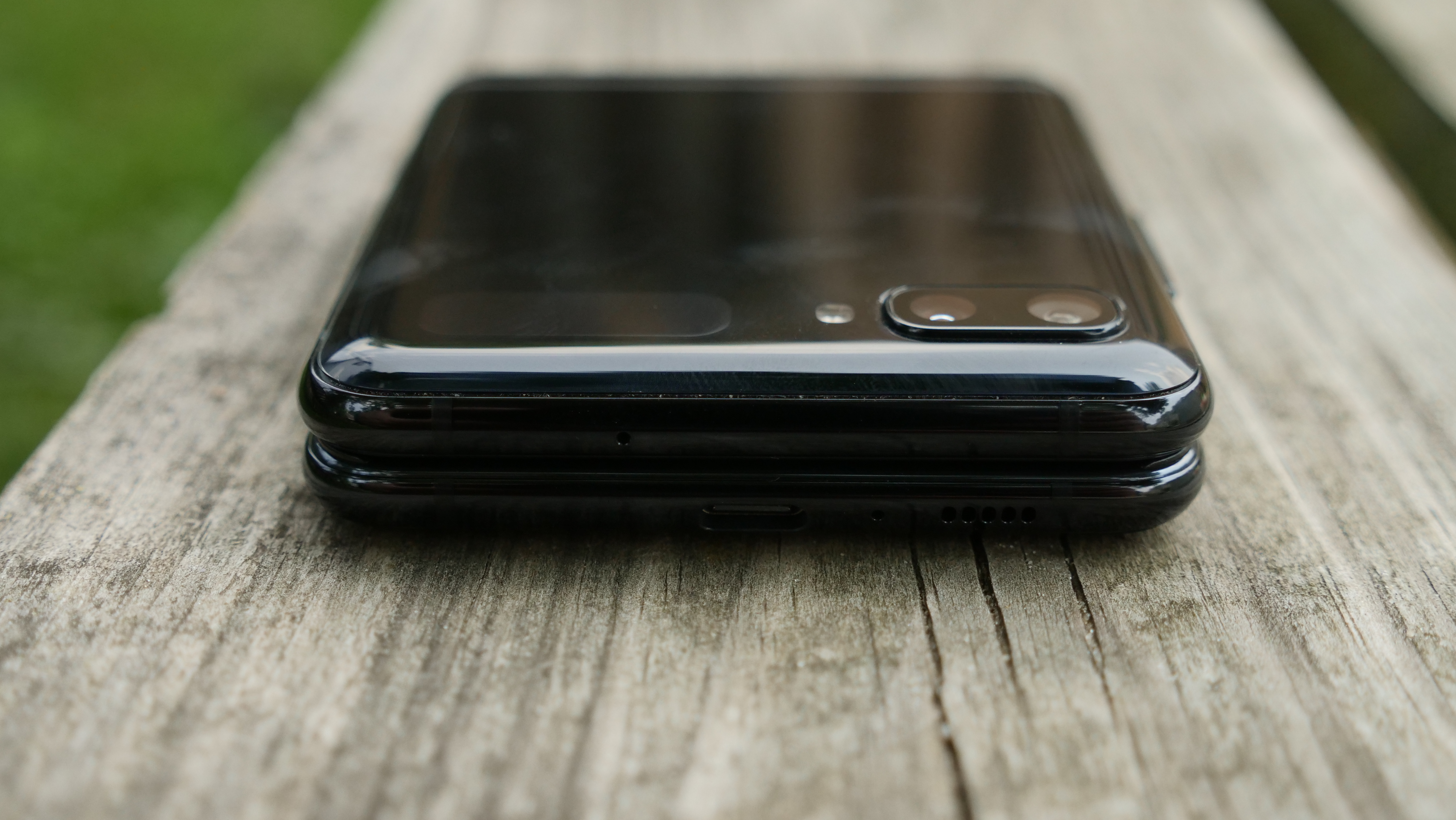
Samsung Galaxy Z Flip 5G: Battery life and charging
The Galaxy Z Flip 5G relies on a 3,300mAh battery, which is nowhere near what you expect from a modern Android flagship. For comparison, the Galaxy S21 Ultra is a beast with a 5,000mAh battery and even the Galaxy S21 with its 6.2-inch display packs a 4,000mAh battery. I had no difficulty killing the battery on the Galaxy Z Flip 5G in a day if I pushed it, but this phone isn’t meant to be used that way.
While you can’t use the cover display on the Galaxy Z Flip 5G for much, it will save you from turning the phone on to check the time or a notification. With this in mind, you should have less screen-on time throughout the day with this phone versus a traditional phone. I found this to be the case. On a day when I was running the phone through the gamut of testing, I had no trouble killing it by around 4:30 p.m. after taking it off the charger at 7:30 a.m. However, once I settled into a more standard daily usage, I made it to 10:30 p.m. with roughly 10-15% battery remaining. It’s a little close for comfort, but not a phone I would have to charge up midday on a regular basis.
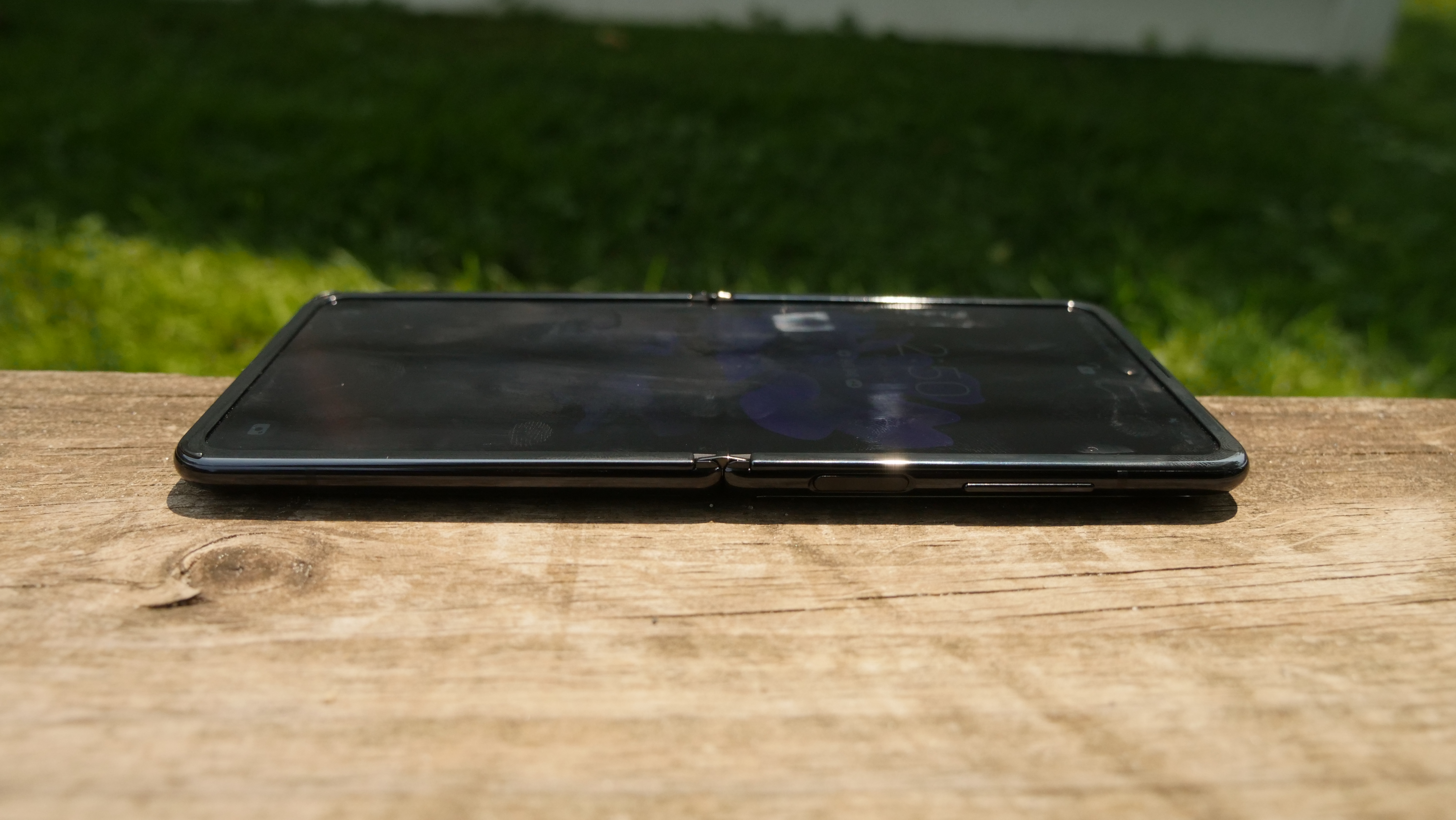
In our battery test, which has the phone continuously web surfing at 150 nits until it shuts down, the Galaxy Z Flip 5G held on for 8 hours and 16 minutes. That’s no threat to the phones with the best battery life, and we like to see a phone hit around 10 hours to guarantee a full day of usage.
You shouldn’t need to unfold the phone every time you have to glance at it and that’s how Samsung is clearly viewing things. The Galaxy Z Flip 3 isn’t rumored to increase the battery size from the Galaxy Z Flip 5G, but the exterior display is getting larger. The next version could get a battery boost if it can offload even more work from the interior display.
The Galaxy Z Flip 5G supports 15W fast charging and fast wireless charging. It would have been great to get the 25W fast charging of the Galaxy S21 lineup because, with its relatively small battery, that speed would have led to impressive charging times. As it is, in 15 minutes, we got up to 23%, and in 30 minutes, it charged to 43%. With phones like the OnePlus 9 Pro able to hit 99% in 30 minutes, it is time for Samsung to up its fast charging game.
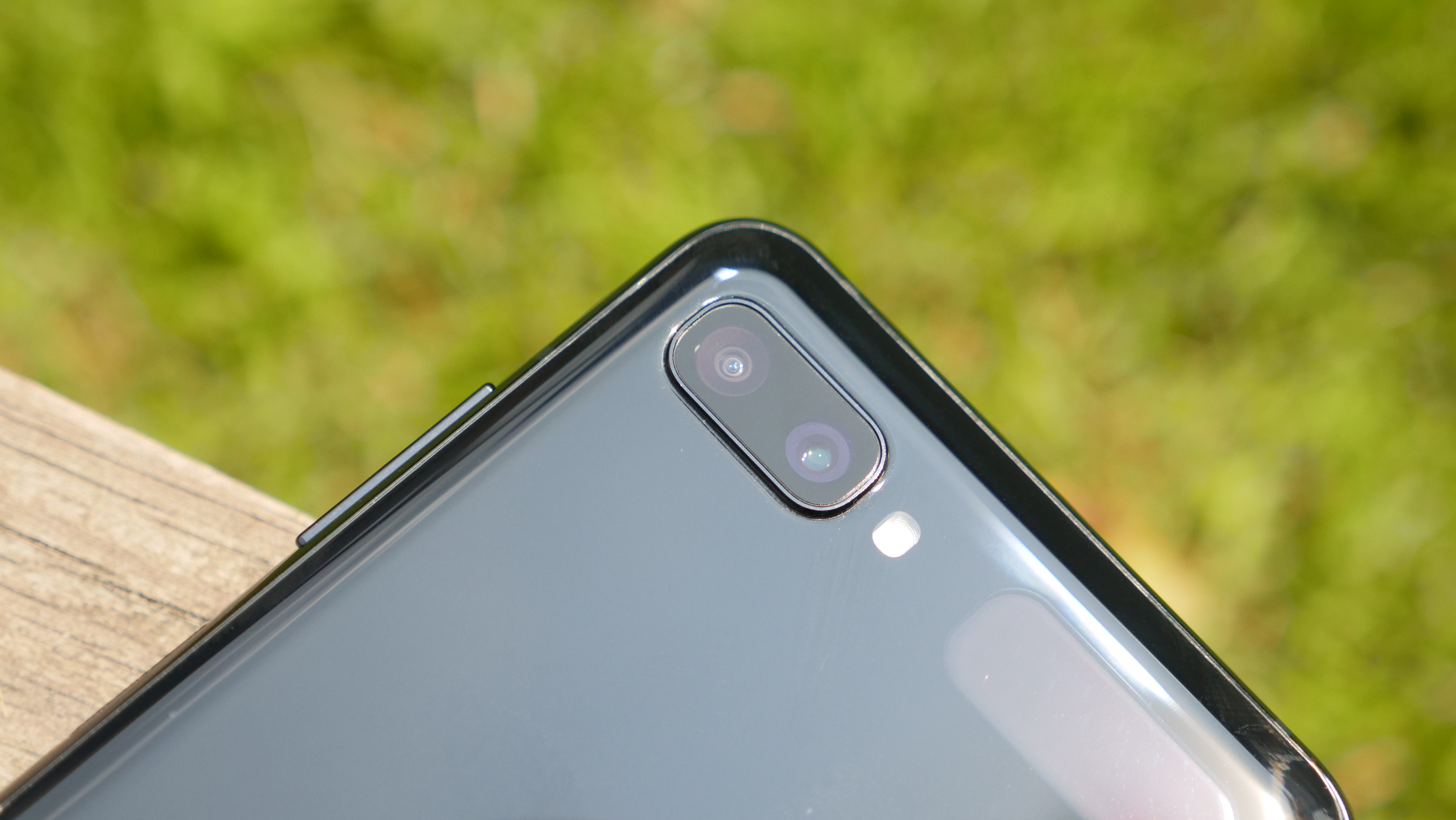
Samsung Galaxy Z Flip 5G: Cameras
The Galaxy Z Flip 5G cameras aren’t as versatile as the array you get with Galaxy S21 line as you are limited to a wide-angle and ultra-wide. That isn’t a criticism of the sensors themselves, but rather, the lack of a telephoto lens. The wide-angle is 12MP at f/1.8 and the ultra-wide also offers 12MP, but at a slower f/2.2. The front-facing hole-punch camera drops down to 10MP at a reasonable f/2.0.
Samsung has taken significant strides with its camera software in the last year or so and the Galaxy Z Flip 5G is no exception. Here’s a collection of samples from the wide-angle and ultra-wide lenses. I threw it a bit of a curveball by shooting from a shaded area into a brightly lit midday environment behind it, and the HDR held up excellently, nailing the exposure in both the shaded areas and the brightly lit field, pond and sky beyond.

Samsung Galaxy Z Flip 5G wide-angle

Samsung Galaxy Z Flip 5G ultra-wide

Samsung Galaxy Z Flip 5G 8x digital zoom
These shots of our garden show the accurate color reproduction from the Galaxy Z Flip’s cameras; they push the saturation slightly, but only marginally and it’s the kind of hyperreal that I prefer. If you want something more natural, try using the full manual controls available in the camera app.

Samsung Galaxy Z Flip 5G wide-angle

Samsung Galaxy Z Flip 5G ultra-wide

Samsung Galaxy Z Flip 5G 8x digital zoom

Samsung Galaxy Z Flip 5G wide-angle

Samsung Galaxy Z Flip 5G ultra-wide

Samsung Galaxy Z Flip 5G wide-angle

Samsung Galaxy Z Flip 5G ultra-wide
The front-facing camera was no different; I gave it the same tough environment I tried on the rear sensors and it was up to the challenge of keeping my exposure without blowing out the background. If you want to use that superior wide-angle camera on the back instead of the front-facing camera, just tap the icon in the upper-right corner of the camera app and you’ll get a preview on the cover display. You can then snap your selfie using the volume up button as the shutter.

Samsung Galaxy Z Flip 5G front-facing camera

Samsung Galaxy Z Flip 5G front-facing camera
Samsung Galaxy Z Flip 5G: Software
The Galaxy Z Flip 5G is running Android 11 with One UI 3.1, the Android skin from Samsung. While it’s a break from stock Android, it doesn’t take long to adjust. After a month of bouncing primarily between One UI 3.1 and OxygenOS 11 from OnePlus the subtle changes grew on me. With Android 12 being a substantial departure from the current look of Android, it will be interesting to see how some of the manufacturers respond with their skins.

Basic user interface aside, there are a number of interesting software features that are exclusive to the Z Flip 5G (and the Galaxy Z Fold 2) due to the folding displays. Flex Mode is the most important of these as it is something a slab phone can’t match. If you have the phone half-folded for a video call, for example, it will present the image above and the controls below. That same trick can be applied when using the camera, giving you a viewfinder with full camera controls on the bottom without interfering with your view of the shot. On YouTube, you can watch a video in the top screen while scrolling through the description or comments below. I’m hopeful that as the foldable market grows we’ll see more developers add support for this in their apps.
However, unlike the Galaxy Z Fold 2, the Galaxy Z Flip 5G doesn’t suffer from the shortage of developers designing for it as in its unfolded state it is just a traditional phone. You don’t run into the growing pains of using a new category, but you still get to enjoy its unique form factor, which is a definite win.
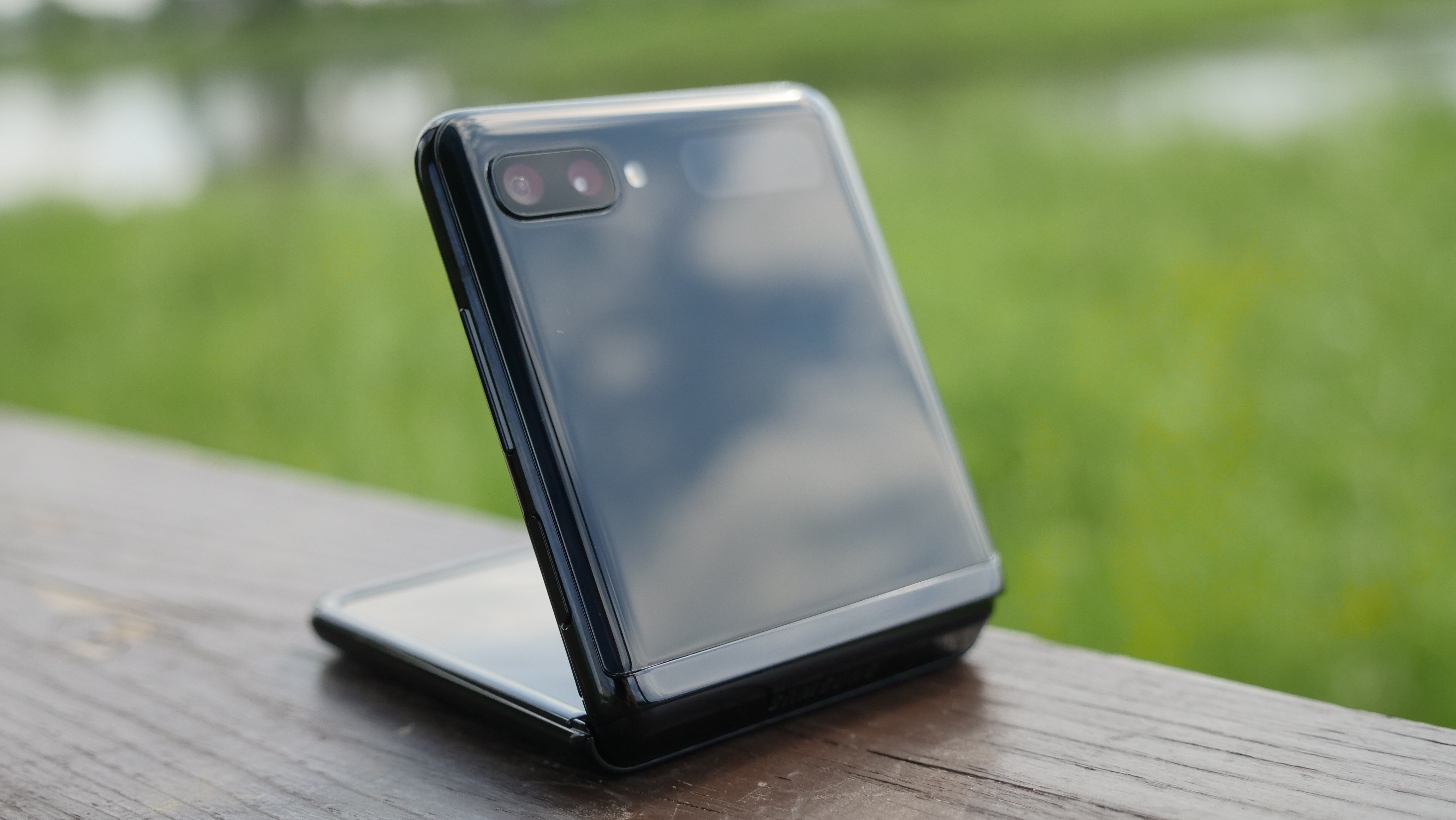
Bottom line
The Galaxy Z Flip 5G wasn’t quite the mind-blowing revelation for me that the Galaxy Z Fold 2 proved to be, but that’s due more to my personal use case and not anything lacking in the phone. We’ve seen over the last year that while there was plenty of praise for the iPhone 12 mini as a smaller device, that hasn’t translated into sales.
I think this is the market the Galaxy Z Flip 5G — and its successor the Galaxy Z Flip 3 — is ripe to actually capitalize on. This phone is tiny in your pocket or bag, but you still get that full large screen experience that virtually every smartphone user has come to appreciate. There’s a reason, beyond the fact that it sounds ludicrous, that the word “phablet” disappeared from our lexicon: every phone is a phablet now. People may want portable, but I’m not convinced that anyone wants to go back to a small display.
The Galaxy Z Flip 5G gives you the best of both worlds and, with even a few upgrades to the Galaxy Z Flip 3 along with that rumored price reduction, this may be a huge year for the flip form factor.
Sean Riley has been covering tech professionally for over a decade now. Most of that time was as a freelancer covering varied topics including phones, wearables, tablets, smart home devices, laptops, AR, VR, mobile payments, fintech, and more. Sean is the resident mobile expert at Laptop Mag, specializing in phones and wearables, you'll find plenty of news, reviews, how-to, and opinion pieces on these subjects from him here. But Laptop Mag has also proven a perfect fit for that broad range of interests with reviews and news on the latest laptops, VR games, and computer accessories along with coverage on everything from NFTs to cybersecurity and more.
